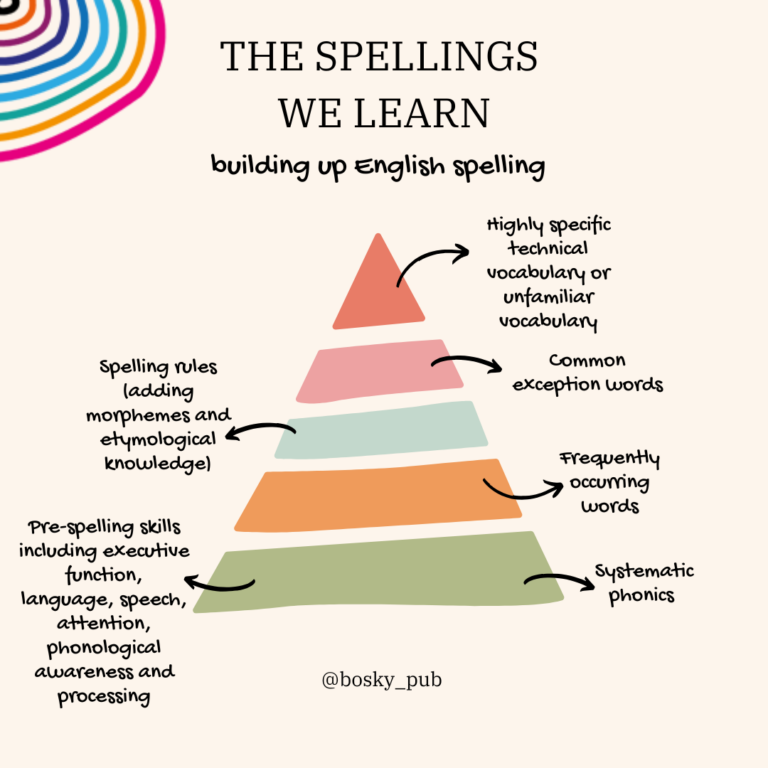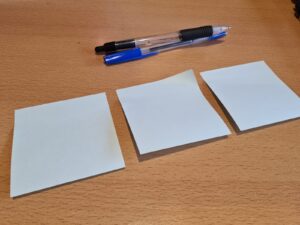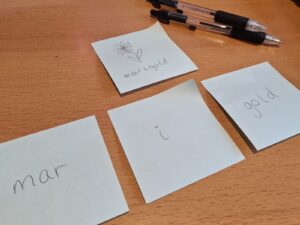How can I help my child with spelling?
Children (and people) have different learning skills which contribute to them learning at school. There are lots of skills:
- speech skills
- language skills (which involves listening to, understanding and using vocabulary and sentence structures)
- attention skills – being able to focus on more than one thing at a time and for long enough to take on board the requirements of a task or activity
- processing skills (how quickly and automatically your brain takes on board information)
- working memory skills (how you can hold all the things you need in your mind and complete a task or activity)
- some of these also come into the broader category of executive functioning which involves attention, working memory, emotional regulation and other aspects
Phonological awareness
Phonological awareness skills are the underlying skills that are developed throughout the Early Years (0-5) in parallel with many of these other skills above. These are skills like being able to hear sounds in words, being able to notice and play with rhyme, noticing the beats and syllables in words, knowing where a word starts and stops so when I hear ‘cuppatea’, I know that means three words: cup/ of/ tea. All of these underlying skills are then built on when we start formally learning phonics which is the sound system that links to individual or groups of letters.
Some children and people might not have strong phonological awareness and therefore find that link between sounds and letters difficult to acquire. They might acquire it after a lot of overlearning but it might not be something automatic and easy.
Why does all of this help with spelling?
Spelling is a different learning skill but it involves lots of the early skills above. You need language skills to know what the word is and phonological skills to be able to hear it and know the sound structure of the word. Then you need to be able to segment the phonemes and know what spelling patterns would be used for each of those. And (!) if it is a long word, you need the working memory and attention to do all of these things throughout the word and in sequence (in order of the sounds that you ‘hear’). Add to that, that in English we have lots and lots of words that don’t correspond exactly to the phonological sound structure that we hear when you say the word. These are found in the common exception word list in the National Curriculum and these words are the ones covered in Step-by-Step to Spelling – the Key Stage 2 common exception word lists.
For spelling, you can imagine this pyramid of learning of the layers of learning going on.

The good thing is that our brains are plastic making new links all the time – we can learn and take on new links that help. For the last couple of years, I had the privilege of tutoring a teen who struggled with literacy. She wanted to work hard (and believe me she really did) to increase her literacy skills. We used a structured programme (which I adapted slightly because of our weekly sessions) to support morphological understanding and automaticity. That’s half way up the pyramid. But it *really* helped and meant that my student was making really good progress with her foundation qualifications that will help her get into college.
At the same time, I wanted to develop a spelling book because I know that for some weekly 1:1 tutoring is not accessible. I know, for example, that all schools in England get a lot of support to deliver their phonics schemes but post phonics, these common exception words are tricky to learn. I wanted parents to have a teacher ‘in their pocket’ who could break down the huge list and give it some sort of structure. I wanted to create lists that had common spelling patterns but that linked to the sound structure of the words where it was relevant. Most of all, I wanted to create something with really short bursts of practice, something incredibly achievable, that could help children to practise a little step at a time. That is why it is called Step-by-Step to Spelling.
Things you can do at home specifically to help spelling:
Here are my easy top 4 things to keep doing at home with words when your child has finished learning the initial phoneme/grapheme correspondences. (Maybe not all of the time! Mostly be as present as possible but that’s a different blog. Make hot chocolate and smores, watch movies, do karaoke, dance in your kitchen, play on scooters, go for walks and read books.)
1. Say words
If your child doesn’t say a word accurately, check that they know the parts of that word but in a positive way. My youngest used to always say ‘plano’ instead of ‘piano’ – there was a point where I needed to repeat back the word in a sentence saying, ‘yes, you played the piano’. I’d call this giving a good model of the word or of language. Even better, tell your child when you learn a new word whether at work or in a book or on telly!
2. Talk about what a word means
Our brains are hearing and filing away the words that we hear and making links all the time. This is a rapid build up to knowing words – by the age of five, children on average know *a lot* of words! My textbooks aren’t recent so I’m pretty sure there will be more recent data points but we are talking about children having vocabularies of around 3000 words at age 3. The links between real things, context and words are always being made (and we refer to these as semantic links). The better we know the word, the better we will know its sound structure and therefore the easier it will be to translate these to writing.
3. Draw a picture
If there is a new word, draw a little sketch that is something to do with the word. It is even better if your child can do this themselves so they are making links with the word and its meaning. Collect the new word sketches somewhere in your house like on your fridge and refer to them. When we draw and say words as well as trying to write them, we call this multisensory learning. This is a good way for our brains to make links.
4. Chunk words into syllables (and use sticky notes)
Count the syllables in longer words and use a sticky note for each syllable of the word. Go through each part and write it down in chunks. You can do this with your child if they aren’t confident. If they aren’t confident with syllables then google ‘chin drop syllables’ to find a good method for doing this. If your child finds it difficult to sequence the sounds in a longer word, breaking the word into the syllabic chunks can be helpful. In my experience, a lot of children will sequence the first couple of sounds and then be much less confident with the sound structure in the middle and at the end of the word.


Will my child find the common exception spellings easy after using the workbook?
In Step-by-Step to Spelling, the focus is on learning the common exception words for Year 3, Year 4, Year 5 and Year 6. These ramp up to some pretty challenging spellings – there are more than a few of them that I write down and look at to remember how they are spelt and I am more than half way to 90 years old!
So the answer is not necessarily. But by looking at each of these words and their meanings, your child will improve their brains ‘filing cabinet’ of spellings. That is because they will know the word better because they have practised, they will have seen it, said it and written it multiple times (overlearning and multisensory learning) and they will have a better understanding of the meaning of the word. Remind them that practice is always valuable and if your attempts at spelling are closer to the correct spelling then you can then use other tools more easily – like a dictionary or a spellchecker.
Hopefully, you can see in the pyramid that there are a lot of different skills that we are using when we are spelling. When your child is at high school level and writing longer pieces, we might need the spelling help of word processors or speech to text apps. This isn’t because spelling is unimportant but it isn’t as important as communicating your ideas for a purpose and/or effectively. But spelling can always get better – someone might teach you a new prefix or suffix or tell you the language that it comes from; you might learn a new technical word and want to be able to use it with clarity when you are writing. It’s not a binary skill or good at it or not – it is always something you can develop or grow. And it doesn’t have to hold you back.
This is my last blog for 2024.
Wishing you a brilliant last couple of weeks of the years, festivities if you celebrate and a joyous start to 2025.
Heather
